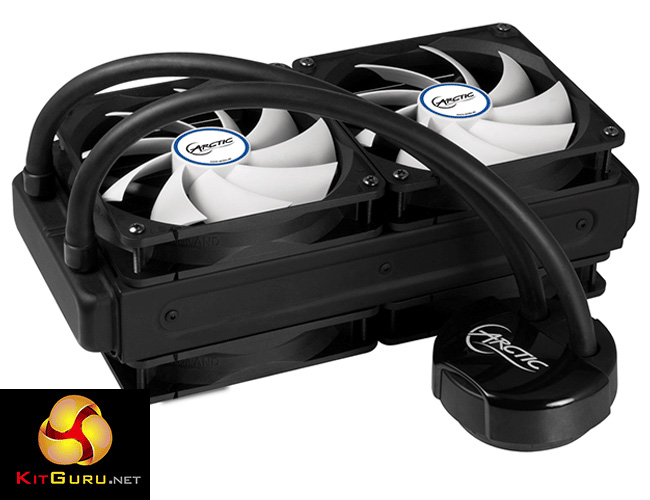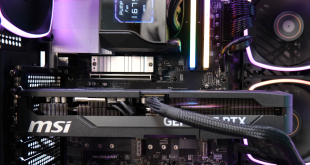Despite the cheaper price of the Arctic Liquid Freezer 240, it is by no means a slouch.
For starters, it looks sleek thanks to its minimalistic design. Installation of the cooler is also very easy, comprising a backplate, four standoffs and then four thumbscrews. Even if you have never installed a CPU cooler in your life, you will have no problems mounting this AIO.
More importantly, cooling performance is exceptional. The Liquid Freezer 240 went right to the top of both of our charts, displacing the Corsair H100i V2 as the ‘KitGuru king of coolers.' Clearly, the extra fans and thicker radiator helps the Liquid Freezer 240 edge ahead.
It is also reasonably quiet – having four fans mean they can spin at a slower speed while pushing a similar amount of air as a single pair of fans at higher speed.
And then it costs just £75.95. That is £34.04 cheaper than the H100i V2, despite it outperforming the Corsair cooler.
As such, the Arctic Liquid Freezer 240 should be making any shortlist if you are thinking of getting a new CPU cooler. I'd even go as far to say as don't even bother with a shortlist – just get this one.
You can buy the Arctic Liquid Freezer 240 from OverclockersUK for £75.95 HERE.
Discuss on our Facebook page HERE.
Pros
- Cheaper than the competition.
- Better performing than the competition.
- Flexible tubing.
- Easy installation.
- Quiet.
Cons
- Four fan cables could get messy.
KitGuru says: The Arctic Liquid Freezer delivers in spades. It offers top performance, low noise levels and a sleek appearance, all for a fair price.
 KitGuru KitGuru.net – Tech News | Hardware News | Hardware Reviews | IOS | Mobile | Gaming | Graphics Cards
KitGuru KitGuru.net – Tech News | Hardware News | Hardware Reviews | IOS | Mobile | Gaming | Graphics Cards






How many watts does the test PC and/or CPU consume at 4.5 GHz under load?
Good question Rob. Next time I get a cooler in for review I will find out and get back to you. I don’t use a GPU, so I can’t imagine much more than 200W – maybe 250.
Wow this sounds great. I just hope I can get all 4 fans to fit into my case!
If it doesn’t fit in your case just put two fans outside and then the radiator and 2 fans inside the case
Also, be sure to have then sucking cooler air from outside rather than the other way around and then fit removable mesh filters to the intakes to cut down on dust being sucked in, this also creates positive pressure in the case so you don’t have to worry about dust being sucked in through every gap and vent hole the case has
If you want to take it a step further get some Perspex or plastic and create a wind tunnel to the rear exhaust fan at the back on most cases. This works like a PSU then taking cooler air from outside but not allowing it once its taken heat from the radiator into the main volume of the case itself as its instantly vented straight out of the back. Modern PSU/case combos do this too by the PSU sucking air through a (normally dust filtered) hole on the bottom and venting straight out of the back. You can even forgo the rear exhaust fan if you want as with 4 fans already sucking the air in I doubt a 5th one at the rear would do much and could be forced to spin faster than it wants by the airflow from the cooler anyway
If you do that however make sure to compensate for the main volume of the cases air flow though by using all other available fan locations as intakes
With a bit of imagination and not that much extra work you can get some excellent results and temps. I’ve been doing it this way for well over 2 decades on desktops and servers, and have even done similar with air coolers using a duct from one intake fan to the intake (push) on an air cooler then another duct from the exhaust (pull) fan on the cooler to an exhaust fan on the case. This makes even the relatively cheap evo 212 work amazingly well especially if you swap out the fans for something like corsair or arctic fans (2z92mm on the cooler and 2×120/140mm as the case intake and exhaust)
I really don’t find a 15 minutes stress test enough for an AIO cooler. Water temperatures don’t equalize in such short time. You should leave it at least 45 minutes under stress to get an accurate measurement. I consider these results invalid.